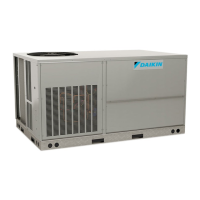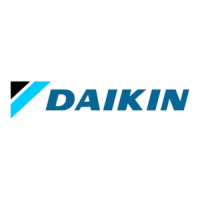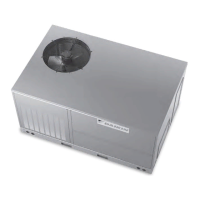SYSTEM OPERATION
14
OBSTRUCTIONS, FAN C LEARANCE AND W IRING
Remove any extraneous construction and shipping materials
that may be found during this procedure. Rotate all fans
manually to check for proper clearances and that they rotate
freely. Check for bolts and screws that may have jarred loose
during shipment to the job site. Retighten if necessary. Re-
tighten all electrical connections.
FIELD DUCT C ONNECTIONS
Verify that all duct connections are tight and that there is no
air bypass between supply and return.
FILTER S ECTION C HECK
Remove filter section access panels and check that filters are
properly installed. Note airflow arrows on filter frames.
AIR FLOW ADJUSTMENTS
When the final adjustments are complete, the current draw of
the motor should be checked and compared to the full load
current rating of the motor. The amperage must not exceed
the service factor stamped on the motor nameplate. The total
airflow must not be less than that required for operation of the
electric heaters or the furnace.
If an economizer is installed, check the unit operating
balance with the economizer at full outside air and at
minimum outside air.
NOTE: Aiflow setting below 300 CFM /Ton is not
recommended, as evaporator freezing or poor unit
performance is possible.
SET EVAPORATOR FAN RPM
Actual RPM’s must be set and verified with a tachometer or
strobe light. With disconnect switch open, disconnect ther-
mostat wires from terminals Y and W. This will prevent
heating and mechanical cooling from coming on. Place a
jumper wire across terminals R and G at TB1 terminal block.
Close disconnect switch; evaporator fan motor will operate so
RPM can be checked.
For gas heat units, the airflow must be adjusted so that the
air temperature rise falls within the ranges given stated on
Data Plate.
EVAPORATOR FAN ROTATION CHECK (THREE PHASE MODELS
ONLY)
Check that fan rotates clockwise when viewed from the drive
side of unit and in accordance with rotation arrow shown on
blower housing. If it does not, reverse any two incoming power
cables at Single Point Power Block. In this case, repeat
bearing check.
Do not attempt to change load side wiring. Internal wiring
assures all motors and compressors will rotate in correct
direction once evaporator fan motor rotation check has been
made.
ELECTRICAL INPUT C HECK
Make preliminary check of evaporator fan ampere draw and
verify that motor nameplate amps are not exceeded. A final
check of amp draw should be made upon completion of air
balancing of the duct system .
BELT DRIVE MODELS ONLY
The drive on the supply fan is typically set in the middle of the
RPM range. The drive motor sheave pitch diameter is field
adjustable for the required airflow.
Upon completion of the air flow balancing, we recommend
replacing the variable pitched motor sheave with a properly-
sized fixed sheave. A matching fixed sheave will provide
longer belt and bearing life and vibration free operation.
Initially, it is best to have a variable pitched motor sheave for
the purpose of airflow balancing, but once the balance has
been achieved, fixed sheaves maintain alignment and mini-
mize vibration more effectively. For direct drive units, move fan
speed wire.
NORMAL SEQUENCE OF OPERATION
COOLING
Begin with power turned off at all disconnects.
1. Turn thermostat system switch to “Cool,” and fan switch
to “Auto” and turn temperature setting as high as it will go.
2. Inspect all registers and set them to the normal open
position.
3. Turn on the electrical supply at the disconnect.
4. Turn the fan switch to the “ON” position. The blower
should operate after a 7 second delay.
5. Turn the fan switch to “Auto” position. The blower should
stop after a 65 second delay.
6. Slowly lower the cooling temperature until first stage
COOL (LOW COOL) starts. The blower, both fans, and
first stage compressor should now be operating. Allow
the unit to run 10 minutes, make sure cool air is being
supplied by the unit.
7. Lower the cooling temperature further until second stage
COOL (HIGH COOL) starts. The blower, both fans, and
both compressors should now be operating. Allow the
unit to run 10 minutes, make sure cool air is being
supplied by the unit.
8. Turn the temperature setting to the highest position,
stopping the unit. The indoor blower will continue to run
for 65 seconds.
9. Turn the thermostat system switch to “OFF” and discon-
nect all power when servicing the unit.
